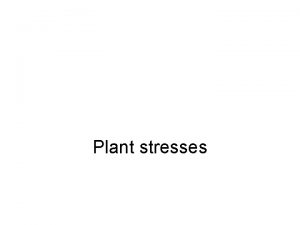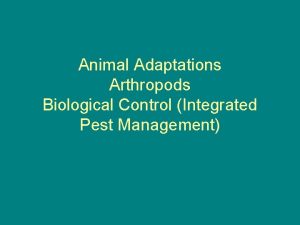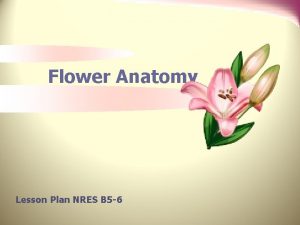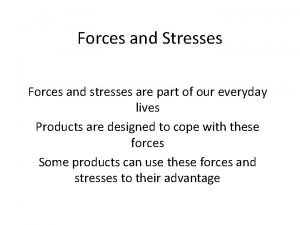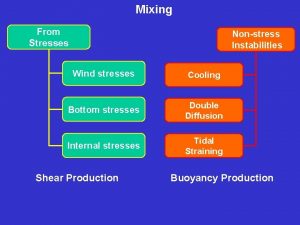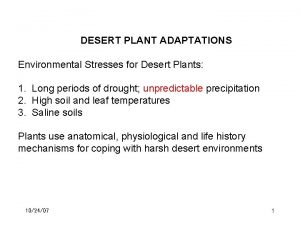Plant stresses Plants are sessile and must deal










- Slides: 10

Plant stresses

Plants are sessile and must deal with stresses in place • Plants cannot avoid stress after germination • How plants deal with stress has implications in – Ecology: Stress responses help explain geographic distribution of species – Crop science: Stress affects productivity – Physiology and biochemistry: Stress affects the metabolism of plants and results in changes in gene expression www. grainscanada. gc. ca • From engineering, stresses cause strains (responses of stressed objects) = changes in gene expression and metabolism in plants Heat-stressed wheat • Biological stress difficult to define/quantify: – What is “normal” metabolism? – Limitations to yield? – Where on gradient of availability of limiting resource does stress begin? • Varies by species, ecotype

Stresses are abiotic or biotic ABIOTIC STRESSES Environmental, nonbiological • Temperature (high / low) • Water (high / low) • Salt • Radiation • Chemical Caused by living organisms • Fungi • Bacteria • Insects • Herbivores • Other plants/competition • Stresses cause responses in metabolism and development • Injuries occur in susceptible plants, can lead to impeding flowering, death • Ephemeral plants avoid stress Fig. 21. 1 Preferable! – Mexican poppies in US desert SW – Only bloom after wet winter – Die before summer returns http: //www. geo. arizona. edu/gallery/US/tuc_2. html

Plants must be stress resistant to survive • Avoidance also possible by morphological adaptations – Deep tap roots in alfalfa allow growth in arid conditions – Desert CAM plants store H 2 O in fleshy photosynthetic stems • Stress resistant plants can tolerate a particular stress • Resurrection plants (ferns) can tolerate dessication of protoplasm to <7% H 2 O can rehydrate dried leaves • Plants may become stress tolerant through – Adaptation: heritable modifications to increase fitness Alfalfa plant Alfalfa taproot • CAM plants’ morphological and physiological adaptations to low H 2 O environment – Acclimation: nonheritable physiological and biochemical gene expression • Cold hardening induced by gradual exposure to chilling temps, a/k/a cold-hardy plants www. agry. purdue. edu; www. omafra. gov. on. ca; Heat stressed rose leaf

Let’s walk through one each of important abiotic and biotic stresses Growth rate • View how they affect metabolism • Determine how the plant responds to counter the stress ABIOTIC STRESS: Temperature • Plants exhibit a wide range of Topt (optimum temperature) for growth • We know this is because their enzymes have evolved for optimum activity at a particular T • Properly acclimated plants can survive overwintering at extremely low Ts • Environmental conditions frequently oscillate outside ideal T range • Deserts and high altitudes: hot days, cold nights • Three types of temperature stress affect plant growth – Chilling, freezing, heat Topt Growth temperature

Suboptimal growth Ts result in suboptimal plant development Chilling injury • Common in plants native to warm habitats Transition temperature – Peas, beans, maize, Solanaceae • Affects – seedling growth and reproduction – multiple metabolic pathways and physiological processes • Cytoplasmic streaming • Reduced respiration, photosynthesis, protein synthesis • Patterns of protein expression Membrane fluidity affects permeability! http: //cropsoil. psu. edu/Courses/AGRO 518/CHILLING. htm • Initial metabolic change precipitating metabolic shifts thought to be alteration of physical state of cellular membranes • Temperature changes lipid and thus membrane properties • Chilling sensitive plants have more saturated FAs in membranes: these congeal at low temperature (like butter!) • Liquid crystalline gel transition occurs abruptly at transition temperature

Biotic stresses are mitigated by plants’ elaborate defense strategies BIOTIC STRESS: Pathogen (e. g. , fungus) invasion • Plant reaction to invading pathogens center around the hypersensitive reaction • The hypersensitive reaction initiates many changes in plant physiology and biochemistry Defenseless Wild type Buchanan et al. , “Biochemistry & molecular biology of plants, ” 2001 – Early activation of defense related genes to synthesize pathogenesis related (PR) proteins • Protease inhibitors to stop cell wall lysis by specific enzymes expressed by pathogen • Bacterial cell wall lytic enzymes (chitinase, glucanase) – Change cell wall composition • Express enzymes providing structual support to cell walls via synthesis of lignin, suberin, callose, glycoproteins – Synthesize secondary metabolites to isolate and limit the pathogen spread • These include isoflavonoids, phytoalexins – Apoptosis at invasion site to physically cut off rest of plant – Sequential or parallel events? ?

How does the plant recognize and defend itself against pathogens? • Plant disease has an underlying genetic basis • Pathogens may be more or less potentially infectious to a host – virulent on susceptible hosts – avirulent on non-susceptible hosts • Pathogens carry avirulence (avr) genes and hosts carry resistance (R) genes • The normal presence of both prevents pathogens from attacking the plant • Infection occurs when pathogen lacks avr genes or plant is homozygous recessive for resistance genes (rr) • In these cases, the plant cannot initiate the hypersensitive reaction • This is bad news! – The plant requires this response to survive! • Note the communication between pathogen and plant • Pathogen: avr genes may code for proteins that produce elicitors – bits of pathogen: polysaccharides, chitin, or bits of damaged plant: cell wall polysaccharides • Plant: R genes may be elicitor receptors

The hypersensitive reaction initiates a plant immune response • The long term plant resistance to a pathogen is similar to a mammalian immune response • This is known as systemic acquired resistance (SAR) • Secondary metabolites induced by the hypersensitive reaction initiate changes in metabolism in other plant organs through control of signal transduction chains • Hours to days: capacity to resist pathogens spreads throughout plant • Immune capacity = SAR • SAR signaling involves salicylic acid (SA), a natural secondary metabolite – SA both induces pathogenesis related gene expression and enhances resistance to infection by plant viruses Fig 21. 17

Salicylic acid induces systemic acquired resistance • Local SA production induces distal production and SAR via volatilize Fig 21. 18 d – SA transport in xylem – Methylation into MSA, volatilization and distal detection • High constitutive SA levels result in plants with high ability to withstand pathogens • Mechanism by which SA induces SAR unknown • Jasmonic acid also mediates disease and insect resistance – JA also mediates other developmental responses: PGR? All stress affects photosynthesis: productivity and survival • Knowledge of how stress is perceived and transduced central to understanding plant metabolism

